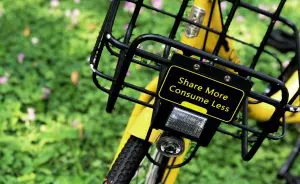Shared forms of mobility, sustainable (re)allocation of space and attractive, inclusive, needs-based access to mobility in residential and business areas are the aim of the iSPACE Sharing Hubs project. Vehicles should be shared in these hubs, while the existing parking spaces are also to be used in more than one way. The spatial decoupling of living/working and parking promotes shared mobility. In addition, these sharing hubs can be equipped with low-cost e-charging infrastructure and supplemented with services such as parcel boxes.

c: Pop Zebra/Unsplash
Dealing with parking spaces in the city is becoming increasingly relevant in view of land sealing, active mobility and the growing influx into cities. Vehicle and parking space sharing in so-called “sharing hubs” can contribute to a solution.
With the new Sharing Hubs project, the RSA FG Studio iSPACE is using FFG funding to find solutions to land sealing and other problems associated with the continued dominance of private transport. The Kairos office, the planning and consulting company Rosinak & Partner ZT GmbH and MO.Point Mobilitätsservices Gmbh are also involved.
Sharing hubs sensitize users to sharing offers, create alternatives to private cars and thus reduce the number of cars needed.
Sharing hubs combine vehicle and parking space sharing and thus bundle traffic areas centrally at suitable locations. As a global trend, shared mobility is already complementing the advantages of active mobility as an alternative to owning a car. However, there is still a lack of approaches as to how these sharing services can be implemented outside of town and city centers and public transport hubs.
Operator models have a dual effect
The iSPACE studio wants to change this with pilot projects in the city of Salzburg and the Rheintal in Vorarlberg. The aim is to develop tools for planning sharing offers, analyze potential areas and link these with business models in order to show decision-makers possible solutions and provide an empirically sound basis for decision-making. The planning and modeling tools developed will provide an overview of how many and what type of sharing hubs are economically feasible at which locations in residential, business and commercial districts. The focus of the project is not only on garages or new parking areas, but also includes existing parking spaces, such as company parking lots.
The project aims to define operator models that work in two ways: On the one hand, parking spaces are to be organized centrally and in a condensed form in order to reduce the number of parking spaces required. On the other hand, (e-)sharing services are to be offered in the company in order to provide alternatives to private cars for a broad user group.
Next stops
First, the project team analyzes needs and opportunities, taking into account socio-geographical, urban planning and mobility-related data. With the help of modeling with geoinformation systems, the basis for an evaluation of the spatial conditions can be developed. This enables the number, type, distribution and density of neighborhood hubs to be dimensioned and a sustainable, economically viable basis to be created.
A special focus is placed on social and gender equality. Adapted mobility solutions that are accessible to all are to be integrated in order to avoid the exclusion of individual groups and make mobility more accessible, especially for previously disadvantaged groups. This includes, for example, adapting equipment and transport services to user needs and ensuring accessibility that is as close to home, barrier-free and safe as possible. In addition, the intelligent decoupling of living/working and parking will offer a wider range of mobility options.


